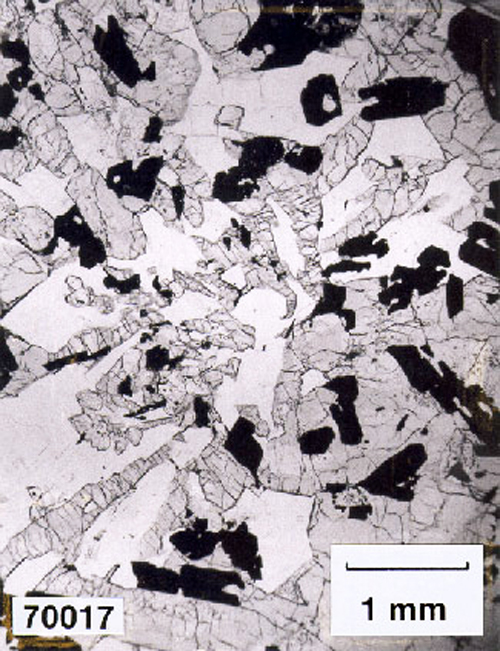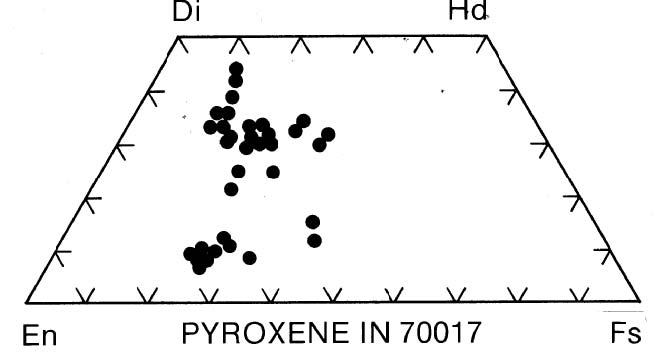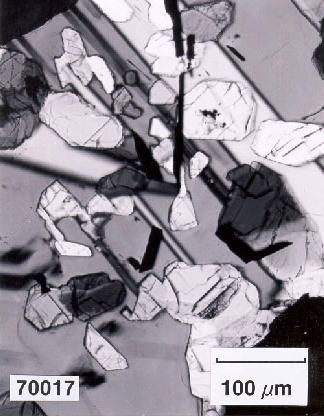
BRIEF DESCRIPTION OF 70017
| Lunar Sample Compendium Link | Lunar Sample Catalog Link | Open University Virtual Microscope Link |
Lunar sample 70017 is a vesicular, medium-grained, high-Ti basalt from Apollo 17. Large, equant, subhedral pyroxene, phenocrysts enclose embayed olivine, ilmenite, and armalcolite (fig. 26). Large anhedral crystals of poikilitic plagioclase (up to 5 mm in some sections) enclose euhedral crystals of olivine, clinopyroxene, and ilmenite. The interstices include abundant silica, trace brown glass, and minor troiliteiron grains. This sample has been studied by Longhi et al, 1974. The sample’s composition is given in table 5.
Figure 26. Texture of mare basalt 70017. Large, subhedral pyroxene phenocrysts enclose embayed olivine, ilmenite, and armalcolite crystals. Note the abundance of opaques in this high-Ti basalt.
Olivine - Olivine Fo69-66 is included in the cores of the clinopyroxene phenocrysts as small, irregular grains and is present as euhedral crystals Fo61, poikilitically enclosed by plagioclase.
Pyroxene - Pink, Ti-rich augite cores of large pyroxenes are surrounded by low-Ti augite and pigeonite. Large pigeonite crystals are surrounded by low-Ti augite rims. In this basalt, there was little Fe enrichment during crystallization (fig. 27).
Figure 27. Composition of pyroxenes in 70017. Pigeonite cores are surrounded by subcalcic-augite rims.
Plagioclase - Large plagioclase grains An88-69 do not penetrate the cores of clinopyroxene. Plagioclase poikilitically encloses olivine and pigeonite (fig. 28).
Figure 28. Partially-polarized-light photo of polysynthetic twinning in plagioclase poikilitically enclosing equant olivine crystals in 70017.
Figure 29. Embayed, euhedral ilmenite in 70017. This is a reflected light photo.
Opaques - Both ilmenite and armalcolite are present in this rock but it is hard to tell them apart. Ilmenite is generally anhedral (embayed), although it was originally lath-like. Exsolution lamellae of Cr-spinel and rutile are included in ilmenite (fig. 29). Minor armalcolite has slightly darker reflectivity and has characteristic “barrel-shaped” boundaries in the elongate direction but euhedral shape in cross section (fig. 30). It occurs in glomerophyric clusters of small crystals enclosed in clinopyroxene.
Mesostasis - A very complex mesostasis of glass, silica, troilite-iron, and trace tranquillityite occurs in this rock. Look for the distinctive cracked appearance of silica in reflective light (fig. 31). Rb-rich glasses are associated with ilmenites such that “ilmenite” separates provide the highest Rb “phase” for Rb-Sr isochrons of high-Ti lunar basalts.
Petrogenesis - Early formed, armalcolite reacted with the liquid and ilmenite eventually became the stable Fe-Ti-oxide. This quickly cooled basaltic liquid has been considered a primitive lunar basalt. High-pressure melting experiments by Longhi et al. 1974 show that this liquid can be generated by partial melting of an olivine-clinopyroxene-ilmenite source at depths of 100 to 150 km in the Moon. Sample 70017 is about 3700 million years old. The old ages of Ti-rich basalts indicate that these liquids were generated shortly after the giant impacts that produced the basins.

Figure 30. Barrel-shaped armalcolite in 70017. The armalcolite is very hard to distinguish from ilmenite except by its habit. It is hexagonal in cross section but tapered in the elongate direction. This is another reflected light photo.
Figure 31. Reflected light photo of cracked silica in 70017.





